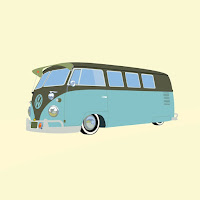~What is Graphic Design~
- art & design elements are basic units of a visual image
- principles of design govern relationships of the elements used and organize the composition as a whole
- all imagery, art, design, and photography alike are comprised of elements that can be broken down and analyzed but its visual components & the principles that guide them
~ELEMENTS~
SPACE
-can exist in two or three dimensions
-can refer to positive or negative space
-can refer to foreground, mid or background elements
LINE
-basic element that can vary in thickness, texture, & direction
COLOUR
-can evoke psychological affects
-ex. bright colours indicate excitement & red, brown & yellow indicate an appetite
SHAPE
-organic, geometric, abstract
-used to identify certain characters and objects
-more difficult to do with people
TEXTURE
- created through layering & value
- either real or implied
-adds depth and quality to work
VALUE
- adds dimension to something
-gives illusion of depth
-value and texture can be close in execution
BALANCE
- 4 types = balanced, unbalanced, symmetrical & assymmetrical
- a sense of visual weight
~PRINCIPALS~
UNITY
-creates a sense of order, or a consistency of size and shape
-can create or show a lack of unity
VARIETY
-idea of similar, yet different components within elements
REPETITION
-repeat elements within a design
HARMONY
-similar elements being used and repeated in an aesthetically pleasing fashion
PROXIMITY
-change of distance between element
-used to guide how we use space
- control emphasis through proximity
PROPORTION
-change of scale
-used to create visual illusions, depth & space
-can also change perception
-golden spiral/fibonacci sequence = breaks things down into thirds
-rule of thirds = more pleasing
-ex. landscape photographers using upper thirds for horizon line
EMPHASIS (Focal Point)
-use elements (colour, shape, line, etc.) to create emphasis
-many fail to achieve this
FUNCTIONALITY
-"Don't make something unless it is both necessary and useful; but if it is both necessary and useful, don't hesitate to make it beautiful."
Tuesday, September 29, 2015
Monday, September 28, 2015
Thursday, September 24, 2015
Wednesday, September 23, 2015
file format practice - trees photo
trees.jpg (progressive) (original)
trees.jpg (baseline)
trees.jpg (baseline optimum)
trees.png
trees.tif
trees.gif
trees.gif (diffuse)
trees.gif (noise)
trees.gif (pattern)
trees.bmp (16bit)
trees.bmp (24bit)
trees.bmp (32bit)
In this set, my results are similar to the last; the file's original format was much better suited than the other formats it was resized into. The only difference was that the original file format was in jpg, specifically progressive jpg.
No matter how it was resized, the reformatted pictures lost quality merely because they couldnt handle the precise detail, or colour gradients. For instance, the gif formats gave the picture unnecessary noise while bmp formats saturated and thickened the sky gradients.
Tuesday, September 22, 2015
file format practice - bus
bus.png (original)
bus.jpg
bus.jpg (baseline)
bus.jpg (progressive)
bus.gif
bus.gif (diffuse)
bus.gif (noise)
bus.gif (pattern)
bus.bmp
bus.tif
Upon compiling each image, I feel that the original bus image in png had the best quality and size
by far. The alternately compressed images had issues with both of these factors. For example, when compressing all 3 bmp formatted images, there was a slight dullness in colour as well as crispness in the lines. Gif format had given a peculiar warbliness to the image, and the rest of the formats had slight feathering to them when attempting to size the image larger. Png format had none of these problems; instead, it retained it's exact colouring and line crispness even when sized larger or smaller.
Friday, September 18, 2015
Graphic File Format notes
File Formats
~All computer files are packaged in different formats, which is determined by file origin
~Ai & Psd are raw uncompressed files
- must be compressed to share on the internet
Compression
~Ai & Psd are raw uncompressed files
- must be compressed to share on the internet
~Commonly used compression file types include JPG, PNG, GIF, TIFF, etc.
-built for certain types of images, may lower size or quality
-make sure to use right format choice to prevent this from happening
- each compression format has it's advantages and disadvantages
Lossy vs Lossless
~Graphic image formats fall under two catagories of compression, Lossy & Lossless
~Lossy image data is lost or reduced for smaller file sizes due to poor image quality
-"compression artifact"
- generation loss = when a file is compressed multiple times
-ex. JPGs with flat colour
~Lossless regains image data for larger file sizes and higher quality
-Ex. PNG
TIF format
~"Tagged Image Format"
~Common format for desktop publishing, print, photo and graphic design
~Lossless file format
~Larger file sizes, unfit for internet display or browser compatible
JPG format
~"Joint Photographers Expert Group"
~Created for digital photography and works best with photographic content
~Lossy format
~Can reduce an image by 10:1 without showing significant compression artifacts
~Adjustable compression levels
GIF format
~"Graphics Interchange Format"
~Best for images with flat colour or tone, like a cartoon
~Reduces image size by "indexing" colour from 3 channels to 1
~Adjusts by changing colour bit levels from 1 to 8
~No DPI (Dots per Inch) data for printing -- unfit for printing
KNOW YOUR PIXELS ~
~2 Types of pixels; contiguous or non contiguous
~TIF and JPG are best for images with pixels that blend in colour, or "contiguous pixels"
~GIF is best for images with flat, even tone, or "non-contiguous pixels"
Alias vs. Anti-Alias
~Alias preserves pixel, while Anti-Alias created gradients to create "smooth" lines
Thursday, September 17, 2015
Wednesday, September 16, 2015
Friday, September 11, 2015
Wednesday, September 9, 2015
Subscribe to:
Posts (Atom)

































